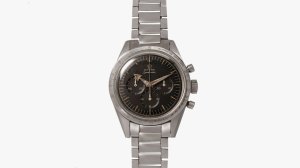The world was a very different place in 1957. Flush with post-War affluence and influence, the United States vied with Russia for dominance in the Space Race. The scientific community celebrated global collaboration via the International Geophysical Year. The slow but steady transition to knowledge work saw many take up jobs in the big cities—flush with cash and time, they enjoyed a newfound sense of leisure.
Omega, established in La Chaux-de-Fonds in 1848, was already an important name in horological circles by the mid-20th century. Having produced numerous excellent sport timers, pocket watches, and early automatic movements, it turned its sights on a suite of three tool watches that would subsequently enter into legend: the Seamaster dive watch, the Railmaster field watch, and the Speedmaster chronograph. Made for SCUBA divers—a fairly new recreational sport in the mid-1950s—the Seamaster would become a staple in the category. The Railmaster, with its antimagnetic design, would prove somewhat less popular, perhaps due to its idiosyncratic and highly specific use case. The Speedmaster, however—a watch made “for men who reckon time in seconds”—would quite literally exit Earth’s orbit and return home a hero.
Although much has been said about the Speedmaster’s origins as a racing watch—perhaps given the name—the model’s unique feature was what the brand referred to early on as the “tacho-productometer” (T.P.M.) bezel. This scale, called more simply a “tachymeter” today, had long featured on watch dials in order to compute speed or distance. In moving it to the bezel and freeing up dial real estate for a triple-register chronograph, Omega had brilliantly designed a sort of early mechanical wrist-computer. And beyond calculating, say, the distance to an enemy artillery position or the speed of a race car, the “tacho-productometer” bezel could also be used to compute the frequency of an event in units per hour (aka production). It’s thus no wonder that early Speedmaster advertising touted the watch as well suited to “scientists, engineers, T.V. and movie directors, athletes, and their coaches.” Here, finally, was a true tool, in a water-resistant, stainless steel case, meant for the working professional.
In 1964, the National Aeronautics and Space Administration (NASA) put forth a tender calling for a wristwatch that could be used during both training and spaceflight. Four out of 10 companies responded to the call, including Rolex, Longines-Wittnauer, Hamilton, and Omega. It was the latter’s Speedmaster ref. 105.003 that beat NASA’s battery of torture tests, including exposure to searing and freezing temperatures, extreme shocks, low and high pressure, and more. Acceptance by the American space program and subsequent use during the Moon landing in 1969 ensured the watch’s place in history—to this day, the “Speedy” is still the only flight-qualified watch for EVA (“Extravehicular Activity”) some 60-plus years after its initial approval.
Delineating each and every Speedmaster reference would be a fruitless errand — tiny nuances during early production years mean that there are quite literally countless inscrutable variants within single reference numbers. However, this guide should serve as a handy reference to some of the most notable Speedmaster from each decade of production, much as our guides to the Audemars Piguet Royal Oak and the Vacheron Constantin Overseas do the same.
From the very first straight-lug cased Speedy in 1957 to the modern white-dial iteration, this incredible chronograph has shaped the horological landscape unlike perhaps any other model from any other brand. What began life as a scientist’s or athlete’s tool is today a global phenomenon, with the #speedytuesday hashtag disseminating the legend of this simple, hand-wound chronograph to all and sundry. Despite its evolution from humble piece of equipment to luxury product—with price tag to boot—the Speedmaster continues to capture the imagination of not only the watch-buying public, but also the larger population.
-
1950s: Omega Speedmaster ref. CK2915
Image Credit: Analog:Shift Introduced in 1957, the ref. CK2915 is the very first Speedmaster. With its straight-lug case, broad arrow handset, and steel bezel, it’s easily recognizable and distinct from the later flight-qualified “Professional” models that went into space. Omega’s decision to move the tachymeter scale from the dial to the bezel—which allowed for better legibility when making computations—was a brilliant feat of design that would later be copied by numerous other companies. Powered by the hand-wound Omega-finished Lemania cal. 321, the CK2915 was produced through 1959, making it an incredibly rare and valuable bird.
Reference: CK2915
Diameter: 38.5 mm
Movement: Omega cal. 321 hand-wound
Price on Secondary Market: $100,000+ -
1950s-1960s: Omega Speedmaster ref. CK2998
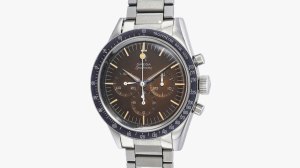
Image Credit: Phillips The ref. CK2998 is where the Speedmaster begins to look more like the modern “Professional” models: The broad arrow hands have evolved into alpha hands on their way to baton form, and the tachymeter bezel is now printed as white text over a black aluminum insert; later executions replace the subregister alpha hands with modern stick versions. The case isn’t yet the “twisted lug” version of the Professional series, but rather the crown guard-less symmetric version of the previous reference. American astronaut Wally Schirra wore a reference CK2998 during the Mercury Atlas 8 mission in late 1962, marking the first use of the Speedy in space.
Reference: CK2998
Diameter: 38.5mm
Movement: Omega cal. 321 hand-wound
Price on Secondary Market: $50,000-$80,000 -
1960s: Omega Speedmaster ref. 105.003
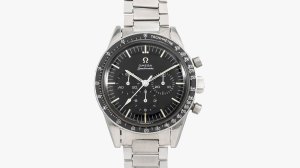
Image Credit: Analog:Shift The ref. 105.003 is the Speedmaster that NASA would qualify for manned space flight, though as production began in roughly 1964 and the Moon landing took place in July 1969, it’s still a “pre-Moon” watch and thus doesn’t bear the flight qualification caseback of later Professional references. Featuring baton hands and larger pushers, the ref. 105.003 in its several iterations was the last vintage Speedmaster to feature the straight-lug 38.5 mm case. American astronaut Ed White famously wore this reference during his Gemini IV spacewalk in 1965, giving it a well earned place in NASA lore.
Reference: 105.003
Diameter: 38.5 mm
Movement: Omega cal. 321 hand-wound
Price on Secondary Market: $8,000-$28,000 -
1960s: Omega Speedmaster ref. 105.012
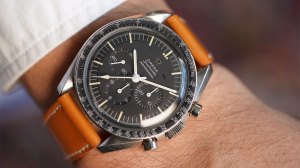
Image Credit: Wind Vintage In circa 1964 Omega introduced the 42mm lyre-lug case that has since become associated with the Speedmaster Professional. This case, with its “twisted” lug shape and crown guards, offers a potent mix of utilitarian and decorative feel, while its larger profile ensures legibility and protection against the elements. At this point, all of the major Speedmaster characteristics are in place—baton hands, black tachymeter bezel with white printing, hand-wound mechanical movement, aforementioned case, etc.—that would come to define the watch for generations of collectors. Astronauts Neil Armstrong and Michael Collins both wore the ref. 105.012.
Reference: 105.012
Diameter: 42 mm
Movement: Omega cal. 321 hand-wound
Price on Secondary Market: $9,000-$21,000 -
1960s-1980s: Omega Speedmaster ref. 145.022
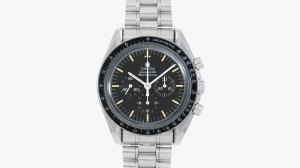
Image Credit: Analog:Shift The ref. 145.022, introduced circa 1968, marked an important transition point for the Speedmaster: Doing away with the column wheel-activated cal. 321, it adopted the less expensive (but more robust) cam-actuated cal. 861, a movement that would remain the Speedy for roughly 50 years. Depending upon iteration, the ref. 145.022 can be either a “pre-Moon” or a Moonwatch and will thus either bear a “The First Watch Worn On The Moon” engraving (in one of multiple configurations) or a more lightly engraved Omega hippocampus logo. Due to its production years, all ref. 145.022 feature tritium dials.
Reference: 145.022
Diameter: 42 mm
Movement: Omega cal. 861 hand-wound
Price on Secondary Market: $4,500-$7,000 -
1960s-1980s: Omega Speedmaster Mark II
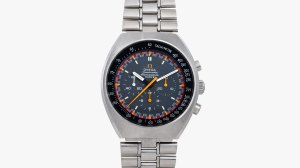
Image Credit: Betteridge Introduced in 1969, the Speedmaster “Mark” series is in some ways a drastic departure from the lyre-lug Professional models—in other ways, it’s still clearly a Speedy: Jettisoning the familiar 42mm asymmetric case, it features instead a circular-brushed tonneau-shape case without crown guards and with the tachymeter bezel moved beneath the crystal. Originally powered by the hand-wound Omega cal. 861, later iterations (Mark III and Mark IV) used the automatic cal. 1040 based upon the Lemania cal. 1341. The Mark II dial, meanwhile, maintained the familiar three-register layout and sword handset of earlier Speed models.
Reference: 145.014
Diameter: 41.5 mm
Movement: Omega cal. 861 hand-wound
Price on Secondary Market: $2,000-$5,000 -
1970s: Omega Speedmaster 125
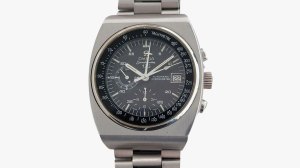
Image Credit: 1st Dibs Introduced in 1973 in celebration of Omega’s 125th birthday, the Speedmaster 125 is likewise a departure from the lyre-lug norm of the typical Professional models: Housed in a decidedly chunky 42mm two-piece tonneau-shaped case with an integrated bracelet, it’s positively dripping with 1970s charm. Powering the watch is the Omega cal. 1041, an automatic movement manifested on the black dial via a 12-hour chronograph counter, a combination 24-hour and running seconds indicator, and a date window at 3 o’clock. Later versions are COSC certified. (In fact, the cal. 1041 was the first automatic, COSC-certified movement.)
Reference: ST 378.0801
Diameter: 42 mm
Movement: Omega cal. 1041 automatic
Price on Secondary Market: $3,500-$5,000 -
1980s: Omega Speedmaster Apollo XI ref. 345.0802
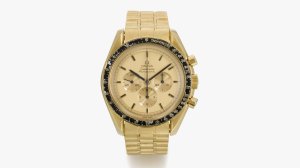
Image Credit: Sotheby’s Produced in commemoration of the Speedmaster’s requalification by NASA for use in its Space Shuttle program, the Speedmaster Apollo XI ref. 345.0802 is a special solid-gold execution produced in 300 yellow and 20 white gold pieces, many of which were sold in the German market. While the typical black aluminum bezel insert is still in place, the printing on the yellow gold model is in gold to match the case and dial shade, while the handset is black. Powered by the cal. 861L (“luxury finish”) hand-wound chronograph movement and paired to a solid-gold caseback, the Apollo XI is a sort of predecessor to the myriad limited editions that exist today.
Reference: 345.0802
Diameter: 42 mm
Movement: Omega cal. 861 hand-wound
Price on Secondary Market: $26,000-$38,000 -
1980s: Omega Speedmaster Moonphase ref. 345.0809
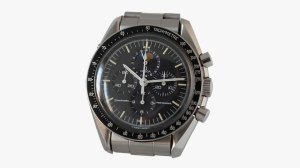
Image Credit: Vesper & Co. Undoubtedly one of the coolest Moonwatches is one with an actual moonphase on it, the ref. 345.0809. With production stated to be roughly 1,300 pieces, this is a rare reference indeed, made in the 1980s and succeeded by other non-Professional versions with moonphase. A standard Professional model in all other regards, the ref. 345.0809 differs from its brethren chiefly in the form of an additional subdial, a combination moonphase and date indicator below 12 o’clock. Powered by the hand-wound cal. 866, it’s perhaps the most utilitarian, no-nonsense moonphase-equipped watch ever devised, with scarcely any decoration to the moon phase disc—and certainly no smiley face.
Reference: 345.0809
Diameter: 42 mm
Movement: Omega cal. 866 hand-wound
Price on Secondary Market: $14,000-$22,000 -
1990s: Omega Speedmaster ref. 3750.50
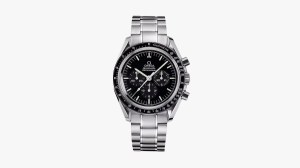
Image Credit: Omega In 1996, the Speedmaster Professional ref. 3750.50 saw Omega upgrade its long-running cal. 861 movement to the new cal. 1861. Functionally identical, these two movements are differentiated only by their finishing, with the 1861 being rhodium- rather than copper-plated (or unplated, depending upon the part). Produced until 2014, the long-running ref. 3750.50 featured the Hesalite crystal of its predecessors as well as a multi-link bracelet—after 1997, however, the brand switched out tritium for LumiNova, marking an end to of an era in which Speedy dials would develop unique patina within their luminous plots and hands.
Reference: 3750.50
Diameter: 42 mm
Movement: Omega cal. 1861 hand-wound
Price on Secondary Market: $4,000-$5,000 -
2010s: Omega Speedmaster “Dark Side of the Moon”
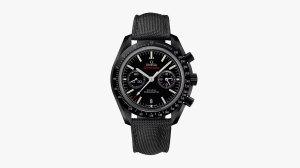
Image Credit: Omega Released in 2013, the oversized, dual-register, black ceramic “Dark Side of the Moon” broke away from the more traditional Professional mold and introduced a new cohort to the magic of the Speedmaster. Measuring 44.25mm in diameter, it features a black case, tachymeter, and dial with 12-hour and running seconds totalizers as well as a 6 o’clock date window — rather than a matching bracelet, it ships on a coated black nylon strap with a foldover clasp. Powered by the brand’s Co-Axial Calibre 9300 movement, it proved to be incredibly popular and soon spurred numerous offshoot models.
Reference: 311.92.44.51.01.007
Diameter: 44.25 mm
Movement: Omega Co-Axial Calibre 9300 hand-wound
Price: $13,400 -
2020s: Omega Speedmaster Calibre 321
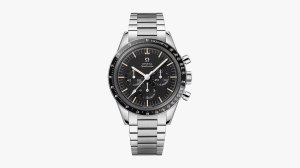
Image Credit: Omega In 2021, Omega introduced a modern version of the ref. 105.003 “Ed White” in stainless steel fitted with the cal. 321 movement, which it painstakingly reproduces and finishes in Sedna gold, rather than copper. Small details—dot-over-90 bezel, straight lugs, a stepped dial, no crown guards—were copied over from the original watch, though modern upgrades include a slightly larger case diameter, Super-LumiNova lume, and sapphire crystals front and back in order to show off the movement. Paired to a contemporary take on the original flat-link bracelet, the new 321 isn’t a limited edition, but is priced well beyond the current-gen Speedmaster due to the limited production of its movement.
Reference: 311.30.40.30.01.001
Diameter: 39.7 mm
Movement: Omega cal. 321 hand-wound
Price: $16,200 -
2020s: Omega Speedmaster Moonwatch Professional Calibre 3861

Image Credit: Omega Available in both “sapphire sandwich” and Hesalite crystal versions, the Speedmaster Professional was upgraded with Omega’s new Master Chronometer-certified caliber 3861 in January of 2021. (The new five-link bracelet, handsome and comfortable, features mirror-polished center links on the sapphire reference and matte finishing on the Hesalite reference.) Vintage callouts—including a stepped dial with sunken chronograph indices and a dot-over-90 bezel insert in aluminum—will satisfy Speedy diehards, while movement nerds will appreciate 15,000 gauss of anti-magnetism, 50 hours of power reserve, and hacking.
Reference: 310.30.42.50.01.001/310.30.42.50.01.002
Diameter: 42 mm
Movement: Omega cal. 3861 hand-wound
Price: $7,300-$8,400 -
2020s: Omega Speedmaster Pilot

Image Credit: Omega A bit of an oddity, the Speedmaster Pilot is nevertheless breathlessly cool: Combining the straight-lug case of earlier Speedies with the modern two-counter aesthetics (and automatic movement) of more contemporary versions, it’s actually a civilian version of a watch made for U.S. military pilots. Inspired, it would seem, by the colorway of the old Omega Flightmaster from the 1970s, it features a grained black dial covered in cheerful orange, yellow, blue, and white accents. The Omega cal. 9900, an automatic movement, powers the dial’s plane-shaped central chronograph seconds hand, running seconds counter, and combination 60-minute and 12-hour totalizer at 3 o’clock.
Reference: 332.10.41.51.01.002
Diameter: 40.85 mm
Movement: Omega cal. 9900 automatic
Price: $10,000
Authors
-

Oren Hartov
Oren Hartov covers the watch industry for Robb Report, GQ, Esquire, MONOCLE, and more. A graduate of the Berklee College of Music and a military veteran, he can be found writing songs and playing…

